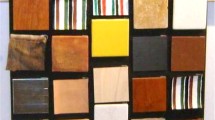Abstract
In the fall of 2001, anthrax-contaminated letters were sent to public figures in the United States. Chemical and radiation treatments were employed to decontaminate exposed buildings, objects, and materials. These treatments are effective, but potentially damaging to exposed objects and materials. The recommended surface chemical treatments include solutions, gels, and foams of oxidizing agents such as peroxides or chlorine bleaching agents. Such oxidizing agents are effective against a wide range of hazardous chemical and biological agents. Knowing how these reagents affect various substrates would help to anticipate and to minimize any potential damage. We are examining the effects on typical museum materials of reagents likely to be used, including hydrogen peroxide, sodium hypochlorite, and potassium peroxymonosulfate. Results so far show significant changes in a number of materials. Surface corrosion was observed on metals such as copper, silver, iron, and brass. Color changes occurred with at least one reagent in about one-fourth of the dyed fabric swatches tested, and about half of the inks. Samples of aged yellowed paper are bleached. Effects varied with both the substrate and the tested reagent. The observed changes were generally less drastic than might have been expected. Enough materials were affected, though, to preclude the use of these reagents on museum objects unless no less drastic alternative is available. It appears that many objects of lesser intrinsic value can be treated without severe loss of properties or usefulness. For example, most documents should remain legible if the appropriate reagent is used. This work will provide a basis for determining which treatment is most appropriate for a specific situation and what consequences are to be expected from other treatments.
Similar content being viewed by others
References
D. Erhardt, C.S. Tumosa, D. von Endt, A.-S.M. El-Easley: ‘Collateral Damage: Anthrax, Gas, and Radiation’. Int. Biodeterior. Biodegrad. (2004), in press
E. Raber, R. McGuire: J. Hazard. Mater. 93, 339 (2002)
C.S. Tumosa, D. Erhardt, C. Solazzo: MAAFS Newslett. 30, 5 (2003)
R.L. Brunelle, M.J. Pro: JAOAC 55(4), 823 (1972)
P.E. Hare, P.A. St. John, M.H. Engel: ‘Ion-Exchange Separation of Amino Acids’. In: Chemistry and Biochemistry of the Amino Acids, ed. by G.C. Barett (Chapman and Hall, New York 1985) pp. 415–425
F. Marte, C. Solazzo, D.W. von Endt, D. Erhardt, C.S. Tumosa: ‘The Effects of Decontamination Reagents on Collagenous Materials Found in Museums’. In: 6th Int. Congr. Cultural Heritage: Context and Conservation, La Havana, Cuba, 2003 (published on CD-ROM)
Author information
Authors and Affiliations
Corresponding author
Additional information
PACS
81.65.Mq; 81.70.Jb; 82.30.Lp
Rights and permissions
About this article
Cite this article
Solazzo, C., Erhardt, D., Marte, F. et al. Effects of chemical and biological warfare remediation agents on the materials of museum objects. Appl. Phys. A 79, 247–252 (2004). https://doi.org/10.1007/s00339-004-2511-7
Received:
Accepted:
Published:
Issue Date:
DOI: https://doi.org/10.1007/s00339-004-2511-7




